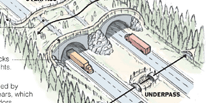
« PREVIOUS ENTRY
PS3 games: Plunging deeper into the “Uncanny Valley”

Highway traffic is an enormous hazard for wildlife; thousands of endangered animals die every year after getting hit by cars and trucks. (To say nothing of the humans that die in these collisions — slamming into an enormous black bear at 60 miles an hour is kinetically equivalent to driving into a brick wall.) Anyway, there’s now an international movement afoot to build traffic overpasses and underpasses catered specifically to animals. A story in yesterday’s New York Times Science section describes one that’s located 50 miles outside Banff, Alberta:
Approached from the woods, the crossover resembles any other sloping hill, covered with brushy grass, shrubs, saplings and even a clump or two of pussy willow.
Earthen berms on either side hide the road and mute the noise of the tens of thousands of cars that pass by daily, winter and summer.
Animals have worn a trail along one edge and, at the top, leave prints on a cleared stretch of dirt, a so-called track pad, monitored by motion-sensitive cameras with night-vision lenses.
It’s working: Researchers have counted tens of thousands of wolves, bears, cougars, and other animals using the overpass in the two years since it was built.
Now here’s a really weird idea: Would this work in an urban setting? Though we tend not to think of cities as hosting much wildlife, in reality places like New York or Toronto teem with everything from squirrels to foxes. They run into problems with traffic too. A terrific story in a recent issue of New Scientist explaining why squirrels are so often greased by cars: They evolved over millenia to cross open spaces as quickly as possible without wasting time to check for predators, because there was nothing they could do hide in that situation, and any delay was just going to increase the likelihood that they’d get killed. (It’s an open question as to whether squirrels will evolutionarily respond to the curious behavior of cars — “predators” that move in predictable straight lines and can be avoided with a modicum of watchfulness.)
In the meantime, though, I wonder if a city could experiment with building little overpasses or underpasses for squirrels? They could actually be quite lovely — metal or wood archworks spanning roads, festooned with climbing vines. Granted, squirrels are hardly endangered species, and it’s possible that automobile deaths constitute an essential herd-culling that is keeping squirrels from booming in population, overrunning cities, and demanding voting rights. But at very least it’d be pretty hilarious to watch ‘em scurrying back and forth across overhighway trellises!
I'm Clive Thompson, the author of Smarter Than You Think: How Technology is Changing Our Minds for the Better (Penguin Press). You can order the book now at Amazon, Barnes and Noble, Powells, Indiebound, or through your local bookstore! I'm also a contributing writer for the New York Times Magazine and a columnist for Wired magazine. Email is here or ping me via the antiquated form of AOL IM (pomeranian99).

ECHO
Erik Weissengruber
Vespaboy
Terri Senft
Tom Igoe
El Rey Del Art
Morgan Noel
Maura Johnston
Cori Eckert
Heather Gold
Andrew Hearst
Chris Allbritton
Bret Dawson
Michele Tepper
Sharyn November
Gail Jaitin
Barnaby Marshall
Frankly, I'd Rather Not
The Shifted Librarian
Ryan Bigge
Nick Denton
Howard Sherman's Nuggets
Serial Deviant
Ellen McDermott
Jeff Liu
Marc Kelsey
Chris Shieh
Iron Monkey
Diversions
Rob Toole
Donut Rock City
Ross Judson
Idle Words
J-Walk Blog
The Antic Muse
Tribblescape
Little Things
Jeff Heer
Abstract Dynamics
Snark Market
Plastic Bag
Sensory Impact
Incoming Signals
MemeFirst
MemoryCard
Majikthise
Ludonauts
Boing Boing
Slashdot
Atrios
Smart Mobs
Plastic
Ludology.org
The Feature
Gizmodo
game girl
Mindjack
Techdirt Wireless News
Corante Gaming blog
Corante Social Software blog
ECHO
SciTech Daily
Arts and Letters Daily
Textually.org
BlogPulse
Robots.net
Alan Reiter's Wireless Data Weblog
Brad DeLong
Viral Marketing Blog
Gameblogs
Slashdot Games